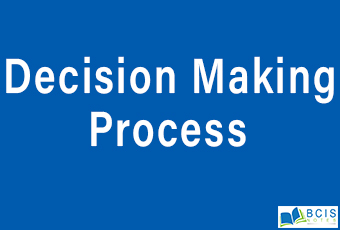
Decision Making Process
Decision making is a continuous and dynamic process. It involves a series of steps. Managers have to follow those steps while taking any decision:
1. Identification of problems
The first step of the decision-making process is to identify the main problems. Generally, the problem arises when there is a deviation between actual and planned performances. It is believed that the identification of problems is the completion of half of the decision-making process. The manager should uniformly monitor the working environment, symptoms of a problem and the root cause of a problem.
2. Analysis of the problem
After the recognition of problems, another step of the decision- making the process to analyze the problems. For this, a decision-maker has to accumulate all the facts, data and information related to problems. The number of facts and the weight of information depends upon the nature and complexity of the problem. A quick analysis of the problems by accumulating all related facts, data and information is must find out the actual source of the problem.
3. Developing alternatives
A problem may have various alternatives solutions. Therefore, all possible solutions should be identified and studied. The decision-maker should have creative and innovative to identify all the alternatives solutions. He has to invest maximum time and effort to develop many alternatives. There might be various sources for identifying alternatives like records and files of problems; opinions and views of exports; discussions with customers, subordinates, creditors, etc.
4. Evaluation of alternatives
After the development of alternative solutions, each alternative should be studied and evaluated in terms of the decision making process. They should be studied by considering the efforts involved and the outcome expected. Generally, the following queries should be focused on while evaluating any alternative solution; firstly, whether the alternative solution is feasible in terms of cost, time, legal constraints; secondly, whether the alternatives are satisfactory for solving the problem; thirdly, whether the consequence of the alternative are favorable to the organization
5. Selection of best alternatives
This is the final stage of the decision-making process after the evaluation of various alternatives. The management has to select the best course of action from many alternatives. Management has to consider both short terms as well as long term impact of alternatives on organizational performance. The selection of the best solution helps for implementation and to gain a positive outcome in organizational objectives.
6. Implementation of alternatives
This is the operational part of the decision-making process. After the selection of the best alternatives, another task of the management is to implement it. Some decision-makers might be good at analyzing and determining alternatives and selecting the best alternative.
7. Review of implementation
The outcome of implementation should be monitored and evaluated from time to time. This is essential to know about the feedback of the performance. The management has to realize that only the implementation of the best alternative will not fulfill the objectives of a decision.
You may also like: Decision Making

Leave a Reply